Industry 4.0 – New challenges for automation
The 4th industrial revolution – also known as Industry 4.0 – describes a development where production companies increase the degree of networking and automation in their value creation chain so high that intelligent machines and systems can process digital product information automatically for the most part and increasingly organise processes autonomously. In this manner, even single pieces can be manufactured according to individual sizes (so-called batch size 1) within a reasonable economical range and thus open up new markets.

Prof. Dr. Henning Kagermann (German Academy of Sciences), Prof. Dr. Wolf-Dieter Lukas (Federal Ministry for Education and Research) and Prof. Dr. Wolfgang Wahlster (German Research Centre for Artificial Intelligence) went public in 2011 with the “Initiative Industry 4.0” and thus coined a term that has found rapid increased use since. By establishing the “Platform Industry 4.0” (2013) for the coordination of the developments, the federal government has declared this as a topic for top management.
In practical application, it is becoming clear that Ethernet- based networks such as PROFINET will gradually replace fieldbus technology and thus become the pathfinder for Industry 4.0 at the production level (operational technology, OT). Networks, which still have a mostly local structure today, will in the future grow together from the classically hierarchic structure of the automation pyramid into a large, complex network of decentralised distributed intelligences (so-called cyber-physical systems, CPS) (see Fig. 2 and 3).

In the face of a vast array of solutions offered by industrial Ethernet-applications, the challenge lies in finding a common system without communications obstacles that satisfies all requirements. It is becoming clear that in the future more interest will be focussed on standard Ethernet and different, parallel existing protocols will drop away. The IEEE task force TSN (Time Sensitive Networking) was created to give real-time capability to standard Ethernet.
Security aspects are gaining importance as well (see below). Thanks to the advances of digitisation, production is increasingly controlled by data that is provided by intelligent sensors and devices. This data can be retrieved directly from the office level (information technology, IT), which likewise communicates via Ethernet. External (unauthorised) access is possible just as well, however.
In order to understand data flows under the conditions of an increasing blending of IT and OT and to ensure security, it is becoming increasingly important to know:
Who communicated what with whom when by which means?
Security for Automation 4.0
The blending with IT however does not permit the acceptance of its security measures for the automation technology. The task for IT is rather to prevent unauthorised external access to data whereas automation technology places its focus on attacks "from inside". Whether they are own staff or visiting service technicians – they can, possibly even unintentionally, cause quality-relevant incidences by supposedly harmless actions such as an active network scan or the loading of firmware updates.
Currently such accesses to the network cannot be regulated without endangering its availability. The correct concept by IT of shielding off to the outside for protecting the data is, however, in direct contrast to the point of view of automation technology with its idea of increasing networking of customers and producers in the whole world. The events need to be recorded, though, to recognise their causes and to even notice such attacks.
Today‘s approach by Indu-Sol is based on the log analysis by permanent network monitoring (PNM). In combination with the network monitoring software PROmanage® NT, the passively operating measurement software and diagnostic tool PROFINET-INspektor® 1G, thereby analyses the logical data traffic in the network. Anomalies, such as unknown participants in the network or delays in the data transmission (so-called jitters, see PROFINET Network Planning), are reported immediately.
When these quality-relevant events are recorded and kept on hand, the operator knows at any time what is going on in his network.
Keep learning:
PROFINET
What is PROFINET?PROFINET Network Planning
ServiceTool
How to use the Indu-Sol ServiceTool to identify the IP of PROFINET devicesPROFINET-INspektor®
How to configure ports in the PROFINET-INspektor®How to set PLC as Master in the PROFINET-INspektor®
How to set-up automatic topology scanning in the PROFINET-INspektor®
How to set-up automatic Switch scanning in the PROFINET-INspektor®
How to get reports and alarms from the web interface of the PROFINET-INspektor®
How to make a manual snapshot in the PROFINET-INspektor®
PROFIBUS
What is PROFIBUS?Learn how to test and diagnose PROFIBUS systems in 5 steps
PROFINET Brochure

PROFINET - Safety for the future explains technological coherences in detail that are based on the latest valid standards and guidelines.
Download
